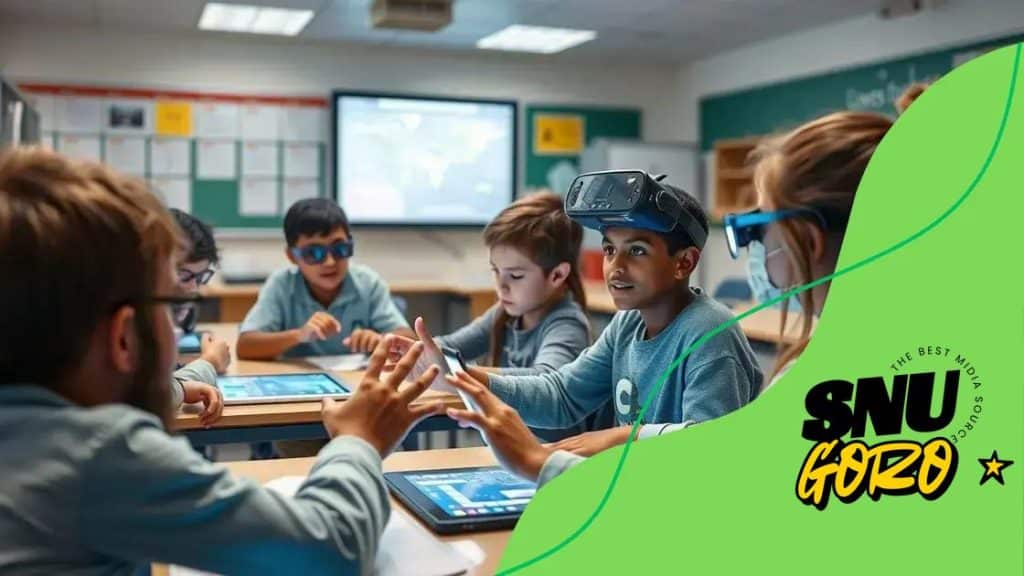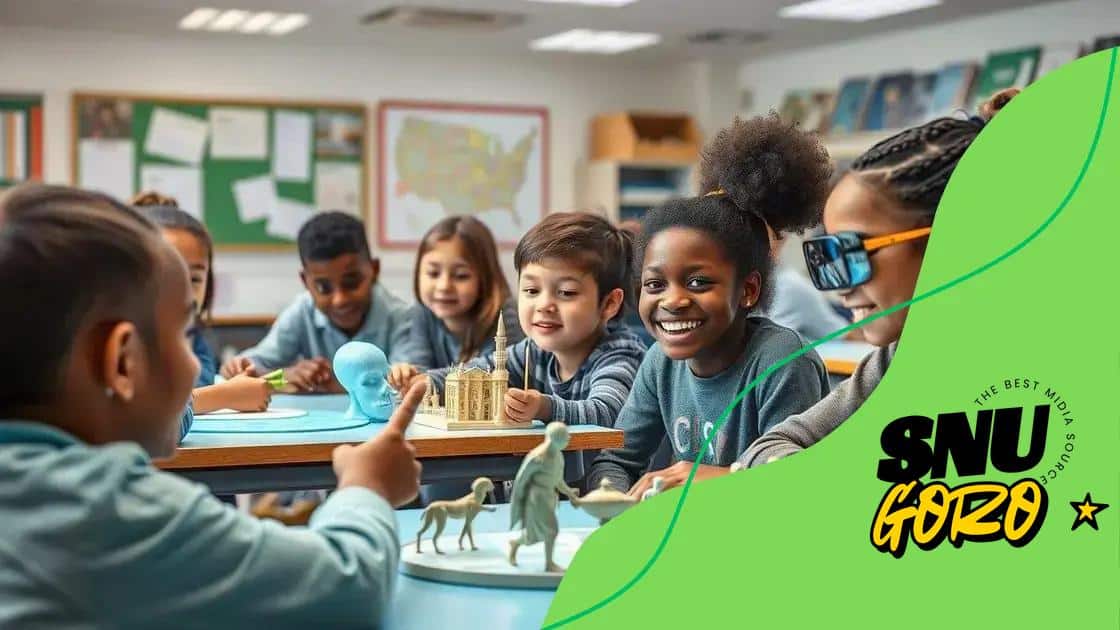How AR is being used for hands-on learning experiences

Augmented reality (AR) is transforming education by creating engaging, interactive learning experiences that enhance understanding and skill development, but challenges like costs and training must be addressed for effective implementation.
How AR is being used for hands-on learning experiences is reshaping education today. Have you ever wondered how virtual elements can make learning more interactive? Let’s dive into the fascinating applications of AR.
Exploring augmented reality in the classroom
Exploring the use of augmented reality in the classroom has become an exciting adventure for both teachers and students. As technology advances, educators are discovering how AR can enhance learning experiences, making them more interactive and engaging.
Incorporating AR into lessons allows students to visualize complex subjects. Imagine studying the solar system and being able to see planets orbiting around a glowing sun right in the classroom. This hands-on experience can make topics come to life.
Benefits of AR in Education
Using AR in education comes with several key benefits:
- Interactivity: Students can actively participate in their learning, reinforcing their understanding of subjects.
- Enhanced Engagement: AR captures students’ attention, making them more excited about learning.
- Creative Learning: Students can think outside the box, exploring unique ways to solve problems.
Beyond engagement, AR can cater to different learning styles. Visual learners benefit from seeing information displayed in their environment. Kinesthetic learners can manipulate objects and see real-time results, which deepens their understanding.
This technology also promotes collaboration among students. They can work together on projects using AR tools, fostering teamwork and social skills. Sharing ideas and findings becomes more dynamic when students can visualize concepts together.
Real-World Applications
Several schools have already begun integrating AR into their curriculums. For example, some science classes use AR applications to explore human anatomy. Students can view and interact with 3D models of organs, making lessons more tangible.
History classes benefit as well by allowing students to tour historical sites virtually. This immersive experience can spark a passion for history while providing a deeper context for students. As AR technology continues to evolve, its potential applications in education seem limitless.
Imagine a future where
Benefits of AR for active learning
The benefits of AR for active learning are numerous and impactful. This technology encourages students to immerse themselves in their studies like never before. By using augmented reality tools, learners can engage with the material in interactive ways that promote understanding and retention.
One of the primary advantages is that AR makes complex ideas easier to grasp. For example, students can visualize difficult concepts through 3D models. This hands-on approach allows them to see how things work in a real-world context, which enhances their learning experience.
Enhanced Engagement
AR captures students’ attention effectively. Instead of passive learning, they become active participants. This engagement leads to increased motivation and excitement in the classroom. Students are more likely to be curious and ask questions when they can interact with the subject matter.
- Real-time Feedback: With AR, learners receive instant feedback on their tasks, helping them improve more quickly.
- Personalization: AR technology can adapt to individual learning styles, catering to each student’s needs.
- Collaboration: AR fosters teamwork as students work together on projects, enhancing social skills.
Additionally, AR helps cater to diverse learning preferences. Visual learners benefit from seeing information presented in engaging formats. Kinesthetic learners thrive when they are able to touch and manipulate 3D objects in their learning environment.
Also, the use of AR in active learning encourages creativity. Students can create their own augmented content, which fosters innovation and independent thinking. By engaging with the material, they develop a deeper understanding of the concepts being taught.
Encouraging Critical Thinking
Another key benefit of AR in education is its ability to promote critical thinking skills. When students use AR to explore different scenarios, they learn to analyze outcomes and make decisions based on the information they gather. This skill set is crucial for real-world applications.
In summary, the integration of augmented reality into active learning leads to enhanced engagement, creativity, and critical thinking. As technology continues to improve, the potential benefits of AR are likely to expand, offering even more valuable opportunities for students to learn effectively.
Case studies of AR in education

Case studies of AR in education illustrate the practical applications and successes of augmented reality in learning environments. These real-world examples provide insight into how educators can enhance student engagement and understanding through innovative teaching methods.
For instance, in a high school biology class, teachers implemented an AR application that allowed students to explore cellular structures in 3D. Students could visualize and manipulate the components of a cell, which made the subject matter much more relatable and easier to grasp.
Successful AR Implementation
In another example, a middle school used AR to teach history. By creating augmented experiences that brought historical events to life, students felt more connected to the material. They could see different aspects of historical battles and explore timelines interactively.
- Engagement: Students showed greater interest and participation in lessons.
- Retention: Information was retained better due to interactive involvement.
- Critical Thinking: Students developed analytical skills as they interpreted augmented experiences.
One remarkable project involved a museum collaboration with a local university. They developed an AR app that guided students through various exhibits. This experience allowed learners to see additional information and visuals overlaid on the displays, enriching their understanding of the artifacts.
Another noteworthy case occurred at a primary school where students learned about the solar system using an AR mobile app. They could point their devices at images of planets to see 3D models with facts about each one. This interactive approach not only captivated students’ attention but also encouraged them to ask questions and explore further.
Challenges and Learning
While there are many success stories, it’s essential to acknowledge the challenges schools face when implementing AR. Factors such as cost, training, and technological limitations can hinder effective adoption. However, those who persist often find that the rewards far outweigh the hurdles.
These case studies of augmented reality in education demonstrate the potential for transforming traditional learning into interactive experiences. As technology evolves, more schools are likely to discover innovative ways to harness AR, shaping the future of education.
Challenges in using AR for teaching
Challenges in using AR for teaching can impact how effectively this technology is integrated into classrooms. While augmented reality has many benefits, understanding its obstacles is crucial for successful implementation.
One significant challenge is the cost of AR technology. Schools must invest in devices and software, which can be expensive, especially for districts with limited budgets. This financial barrier can prevent many educators from exploring AR options.
Training and Adoption
Another challenge lies in training teachers to use AR effectively. Many educators may not be familiar with this technology and need proper training to implement it in their lessons. Professional development programs can help, but they require time and resources that are often scarce.
- Resistance to Change: Some teachers may prefer traditional teaching methods and be hesitant to adapt to new technologies.
- Technical Issues: AR applications can sometimes be unreliable, which can lead to classroom disruptions.
- Lack of Content: Not all subjects have sufficient AR resources available, limiting its use in certain areas.
Additionally, access to the necessary hardware is a critical factor. Students need compatible devices to fully engage with AR lessons. Unequal access can create disparities in learning experiences, particularly in schools with fewer resources.
Time constraints also play a role in the challenges of using AR. Teachers often have packed schedules and may find it difficult to incorporate new technologies without support or flexibility in their lesson planning. This situation can lead to a lack of confidence in using AR effectively.
Addressing the Challenges
Finally, ensuring internet connectivity is essential for AR to function correctly in classrooms. Without reliable internet access, the potential of AR is limited. Schools across regions face different challenges when it comes to technology infrastructure, which can affect implementation.
By acknowledging the challenges in using augmented reality for teaching, educators can better prepare and navigate the obstacles. Schools can develop strategies to overcome these issues and fully embrace the potential that AR offers for enhancing the learning experience.
The future of AR in learning environments
The future of AR in learning environments holds exciting possibilities. As technology advances, education will likely transform in ways we can only imagine today. Augmented reality can provide students with meaningful experiences that enhance their learning journey.
One major trend is the increasing integration of AR into curriculum design. Educators are developing innovative lesson plans that incorporate augmented reality to make learning more engaging and interactive. This change means students will explore subjects more deeply through immersive experiences.
Personalized Learning Experiences
Augmented reality will also allow for more personalized learning. Students will have the opportunity to learn at their own pace, interacting with content tailored to their interests and needs. This customization can lead to improved outcomes and higher student satisfaction.
- Collaborative Learning: AR can enable students to work together in virtual spaces, breaking down barriers between classrooms and fostering teamwork.
- Skill Development: Future AR applications may focus on developing specific skills through simulations, enhancing employability for students.
- Real-World Connections: Augmented reality can bridge the gap between classroom learning and real-world applications, making education more relevant.
Another aspect of the bright future of AR in education is its potential to make learning more accessible. Students with various needs can experience tailored instructional materials. For instance, AR can assist visual learners by providing rich visual representations of concepts.
As more schools adopt AR technologies, the development of educational resources will also grow. Companies will create diverse content suitable for different subjects, ensuring that educators have the tools they need to integrate AR effectively into their teaching.
Challenges to Overcome
While the potential is vast, challenges remain. Schools must invest in infrastructure and training to support the adoption of AR technology. However, with ongoing investments and innovation, these barriers can be overcome.
The future of augmented reality in learning environments promises to make education more engaging, personalized, and relevant for students. Educators and institutions will play a crucial role in shaping how this technology evolves and impacts the learning process.
FAQ – Frequently Asked Questions about Augmented Reality in Education
What is augmented reality (AR)?
Augmented reality (AR) is a technology that overlays digital information, like images or sounds, onto the real world, enhancing the user’s experience.
How can AR benefit students in the classroom?
AR can make learning more engaging and interactive by providing immersive experiences that help students visualize complex concepts.
What challenges do educators face when implementing AR?
Some challenges include costs for technology, the need for training teachers, and ensuring access to necessary devices for all students.
What does the future hold for AR in education?
The future of AR in education looks promising, with opportunities for personalized learning, skill development, and more innovative teaching methods.





